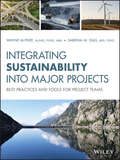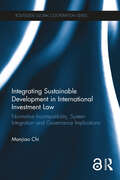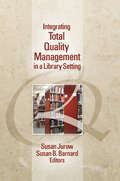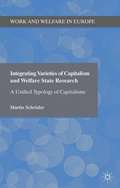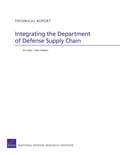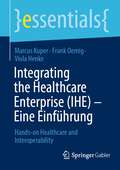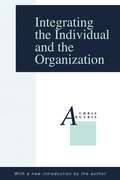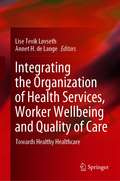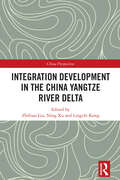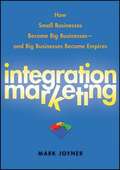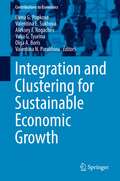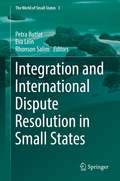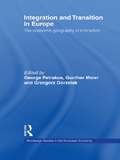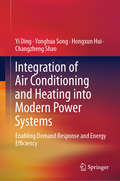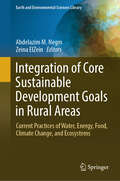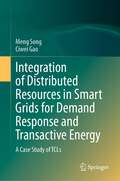- Table View
- List View
Integrating Sustainability Into Major Projects: Best Practices and Tools for Project Teams
by Wayne McPhee Sabrina M. DiasA practitioner-focused guide featuring tools, models, and experience from the front lines of sustainability management on major projects With the growing need for sustainability management on large resource, infrastructure and power projects, this book provides project teams and sustainability practitioners with the practical advice, tools, and resources they need to create better projects. It offers extensive guidance for integrating sustainability into project design, planning and delivery. In each chapter, the authors provide invaluable sustainability management strategies and sample tools for project execution plans, engineering decision-making, stakeholder engagement tracking, logging commitments and follow-up actions, permit tracking, and construction management. Integrating Sustainability into Major Projects: Best Practices and Tools for Project Teams begins by introducing readers to the topic, as well as the common terminology. It then offers readers an overview of major projects, covering types of projects and project structures, the key players, and how to understand and manage different perspectives of time and space. Next, it looks at standards and guidelines, followed by chapters on: Project Management; Managing Risk and Opportunity; Sustainability Management Tools; Approvals and Permits; Design; Procurement; Construction Management; Commissioning; and more. This book: Provides analysis tools and resources that practitioners and project teams can use to successfully integrate and manage sustainability into major project design and delivery including industrial, resource, power, and infrastructure projects; Guides readers on how to work with local communities, engage with stakeholders and develop sustainability programs that support project financing; Includes case studies, lessons learned and expertise from a wide range of actual major projects and the authors' professional experiences with integrating sustainability; Leads practitioners through the major project types and their typical components, structure, and timelines, and demonstrates how sustainability can be effectively integrated into each type of major project. Integrating Sustainability into Major Projects provides the tools project teams need to successfully integrate sustainability into project design and management, making it an ideal tool for project teams and sustainability practitioners working on major resource, power, or infrastructure projects. It will also benefit project owners, organizational leaders, project finance professionals, government regulators and graduate students in engineering, project management, sustainability management, or environmental design and architecture.
Integrating Sustainable Development in International Investment Law: Normative Incompatibility, System Integration and Governance Implications (ISSN)
by Manjiao ChiThe current international investment law system is insufficiently compatible with sustainable development. To better address sustainable development concerns associated with transnational investment activities, international investment agreements should be made more compatible with sustainable development.Integrating Sustainable Development in International Investment Lawpresents an important systematic study of the issue of sustainable development in the international investment law system, using conceptual, normative and governance perspectives to explore the challenges and possible solutions for making international investment law more compatible with sustainable development. Chi suggests that to effectively address the sustainable development concerns associated with transnational investment activities, the international investment agreements system should be reformed. Such reform should feature redesigning the provisions of the agreements, improving the structure of international investment agreements, strengthening the function of soft law, engaging non-state actors and enhancing the dispute settlement mechanism.The book is primarily aimed at national and international treaty and policy-makers, lawyers and scholars. It is also suitable for graduate students studying international law and policy-making.The Open Access version of this book, available at http://www.taylorfrancis.com, has been made available under a Creative Commons Attribution-Non Commercial-No Derivatives (CC-BY) 4.0 license.
Integrating Sustainable Development in International Investment Law: Normative Incompatibility, System Integration and Governance Implications (Routledge Global Cooperation Series)
by Manjiao ChiThe current international investment law system is insufficiently compatible with sustainable development. To better address sustainable development concerns associated with transnational investment activities, international investment agreements should be made more compatible with sustainable development. Integrating Sustainable Development in International Investment Law presents an important systematic study of the issue of sustainable development in the international investment law system, using conceptual, normative and governance perspectives to explore the challenges and possible solutions for making international investment law more compatible with sustainable development. Chi suggests that to effectively address the sustainable development concerns associated with transnational investment activities, the international investment agreements system should be reformed. Such reform should feature redesigning the provisions of the agreements, improving the structure of international investment agreements, strengthening the function of soft law, engaging non-state actors and enhancing the dispute settlement mechanism. The book is primarily aimed at national and international treaty and policy-makers, lawyers and scholars. It is also suitable for graduate students studying international law and policy-making.
Integrating Total Quality Management in a Library Setting
by Susan Jurow Susan BarnardImprove the delivery of library services by implementing total quality management (TQM), a system of continuous improvement employing participative management and centered on the needs of customers. Although TQM was originally designed for and successfully applied in business and manufacturing settings, this groundbreaking volume introduces strategies for translating TQM principles from the profit-based manufacturing sector to the library setting. Integrating Total Quality Management in a Library Setting shows librarians how to improve library services by implementing strategies such as employee involvement and training, problem-solving teams, statistical methods, long-term goals and thinking, and an overall recognition that the system (not the staff) is responsible for most inefficiencies.Total Quality Management in a Library Setting describes the principles of TQM, its origins, and the potential benefits and barriers to be expected when adopting quality management approaches in libraries. Chapters provide guidelines for planning and implementation to help libraries use total quality management to break down interdepartmental barriers and work on continuously improving library services. The contributors, who have begun to think about using or who are already using TQM in a library setting, present specific planning and implementation issues that can be put to immediate use in libraries. With this innovative book, library managers will learn that by working together on problem solving teams to address specific operational questions, and by developing a shared knowledge of problem-solving tools and techniques, staff members grow personally and gain a larger sense of organizational purpose. Other TQM methods introduced in this book include the concept of the internal customer, which teaches staff to recognize how other staff members use the results of their work, and the principle of continuous improvement, which enables libraries to set measurable goals based on quantitative performance indicators, and to monitor progress toward those goals.
Integrating Varieties of Capitalism and Welfare State Research: A Unified Typology of Capitalisms (Work and Welfare in Europe)
by Martin SchröderThis book combines the two most important typologies of capitalist diversity; Esping-Andersen's welfare regime typology and Hall and Soskice's 'Varieties of Capitalism' typology, into a unified typology of capitalist diversity. The author shows empirically that certain welfare states bundle together with certain production systems.
Integrating the Department of Defense Supply Chain
by Eric Peltz Marc Robbins Geoffrey McgovernThe authors provide a framework for an integrated Department of Defense (DoD) supply chain, associated policy recommendations, and a companion framework for management practices that will drive people to take actions aligned with this integrated supply chain approach. Building on the framework and policy recommendations, they identify opportunities to improve DoD supply chain efficiency and highlight several already being pursued by DoD.
Integrating the Healthcare Enterprise: Hands-on Healthcare and Interoperability (essentials)
by Frank Oemig Viola Henke Marcus KuperDieses essential bietet einen Einstieg in das Thema IHE - "Integrating the Healthcare Enterprise (IHE)“ - und hilft sowohl Einsteiger:innen als auch fortgeschrittenen "Interoperabilitätsförder:innen" dabei, zu verstehen, wie IT-Systeme in Gesundheitsunternehmen die richtigen Daten, zum richtigen Zeitpunkt sicher miteinander austauschen können und wie es IHE schafft dafür Lösungen in den verschiedenen medizinischen Domänen anzubieten.
Integrating the Individual and the Organization
by Chris ArgyrisThe emphasis on organizational change in the corporate life of recent years-including job redesign, autonomous groups, high performance work systems, and the redesign of control systems-owes a great deal to the pioneering work of Chris Argyris. This book examines how individuals in organizations can become more effective, in turn making organizations more effective. It explores the conventional pyramidal structure of organizations, in which there is top-down control by managers over workers, and examines their negative consequences. These include organizational injustice and eventually irrational decision-making. Argyris also discusses the characteristic learning system of the modern organization, which he describes as -single-loop- in character. This system, he argues, is only adequeate enough to permit the organization to implement existing policies. It does not permit the more difficult and comprehensive task of questioning underlying goals and assumptions, which he terms -doubt loop- learning. In this kind of learning, the organization is able to confront the more difficult problems that affect organizations in a time of transition. In his new introduction, Argyris reviews the strengths and limitations of the argument advanced in Integrating the Individual and the Organization. He describes why the pyramidal structure endures, and why creating a self-learning organization is an even more challenging task than he has imagined. The book will be of interest to professionals with a long-standing interest in organizational development as well as those just entering the field, managers confronting the challenge of organization change, and researchers in organizational behavior and theory.
Integrating the Organization of Health Services, Worker Wellbeing and Quality of Care: Towards Healthy Healthcare
by Lise Tevik Løvseth Annet H. de LangeThis book introduces the concept of ‘healthy healthcare’ and posits that this new concept is necessary in light of a shortage of healthcare staff in the near future. Healthy healthcare implies that healthcare systems are designed, managed and financed in balance with the available resources to improve workers’ health and performance. Ultimately, a balanced perspective taking into account the patient, the staff and the complex healthcare system will lead to a more resource-efficient delivery of high-quality healthcare services.The book synthesizes evidence-based practice and research on the links between healthcare services, employee health and wellbeing, and quality of healthcare from an interdisciplinary perspective. Written by leading experts in this rapidly expanding field of inquiry, this is the first book ever compiled on the subject with such scope and breadth. It discusses how to conduct interventions and research on healthy healthcare with different populations and settings. The chapters critically examine the links between these pillars; and identify research gaps in both methodology and content from the perspectives of psychology, medicine, nursing, economy, law, technology, management and more. This innovative book is of interest to researchers and students of health sciences, public health, health economics and allied disciplines, as well as to stakeholders in the healthcare industry.Chapter 24 of this book is available open access under a CC-By NC-ND 4.0 license at link.springer.com
Integration Development in the China Yangtze River Delta (China Perspectives)
by Zhibiao Liu Ning Xu Lingchi KongThis book systematically investigates the strategic significance and dynamic mechanisms present in the development of the Yangtze River Delta cluster, one of the major drivers of economic growth in China.The Yangtze River Delta is the most densely populated region in China, with the highest level of economic development. Against the background of China’s national strategy that aims to bolster and augment integrated development on the regional level, this study reviews the development process of the region and possible hindrances to further growth. From a wide array of dimensions, it assesses the key influencing factors, including institutional construction, governance mechanisms, spatial layout, government and corporate competition, the market environment, industrial linkages and synergies, collaborative innovation, public service, and social networks. Based on theoretical analysis and empirical studies, the book advances policy suggestions that help to solve the challenges for integrated development in the region.The volume will benefit scholars and students, as well as investors, business observers, and policy makers interested in the Chinese economy, regional economics, industrial economics, and economic geography.
Integration Marketing
by Mark JoynerPRAISE FOR Integration Marketing "The most important book of the year. " -Codrut Turcanu, founder of Remarkable Blogging, www. RemarkableBlogging. com "Mark Joyner's new book rocks! After reading it yesterday evening, I put all other work on hold to create two integration marketing processes-and have been spreading the word about them. Already, within twenty-four hours, I've started seeing results. And the way I've implemented it is rudimentary and basic. There are so many nuances to make it more powerful and effective. To think so much wisdom and insight can be packed into such a short volume . . . wow! I'm urging everyone I care about in a business sense to stop everything else and read Integration Marketing right now. " -Dr. Mani Sivasubramanian, www. DrMani. name "I've read the book four times in one day. I gave my first lecture on Integration Marketing to my staff today-it generated incredible excitement. " -Alan Walker, CEO, Knowledgism, www. knowledgism. com "[Joyner deserves] a standing ovation for explaining so concisely how McDonald's and Microsoft are able to dominate their markets. " -Ian Del Carmen, President and CEO, Fireball Planet Corporation, www. FireballPlanet. com "My company generated an additional $20,368 in revenue last month as a direct result of Joyner's integration marketing concepts. " -Frank Bauer, founder, Add2It, www. add2it. com "I bought a $750,000 house in cash last year-pretty much because of the Integration Marketing strategies Mark taught us. It's now the major driving force of the growth of our company. " -Tellman Knudson, CEO, Overcome Everything, Inc. , www. OvercomeEverything. com "I must say . . . it's the most important book I've ever read. It's beyond the level of any other marketing strategy. " -Jason Mangrum, author of The Official Internet Business Q&A Report
Integration Through Law: ASEAN Economic Cooperation and Integration
by Chia, Siow Yue and Plummer, Michael G. Siow Yue Chia Michael G. PlummerASEAN economic cooperation and integration have come a long way since the organisation's early days, when cooperation was more political and diplomatic than economic in nature. ASEAN now constitutes the most ambitious organisation of regional cooperation and integration in the developing world. This book investigates the economics of various ASEAN and ASEAN-centric economic integration initiatives, focusing in particular on the ASEAN Economic Community (AEC). In addition to assessing the potential effects of the AEC on the economies of the ten ASEAN member states via changes in trade, foreign direct investment and economic structure, this book underscores the implementation challenges ASEAN faces as it completes the AEC project. It also considers the AEC in the context of the Regional Comprehensive Economic Partnership (RCEP). This comprehensive study is written for academic researchers and students, as well as for policy makers in ASEAN as they chart the future policy path of the region.
Integration Through Law: ASEAN as an Actor in International Fora
by Jürgen Rüland Nguitragool, Paruedee and Rüland, Jürgen Paruedee NguitragoolASEAN as an Actor in International Fora addresses a blind spot in ASEAN research and in comparative regionalism studies by assessing why, how, when and to what extent ASEAN member governments achieve a collective presence in global fora. Written for academic researchers and practitioners working in areas such as international relations, political science and international law, it examines ASEAN's negotiating behavior with a novel four-point cohesion typology. The authors argue that ASEAN's 'cognitive prior' and its repository of cooperation norms have affected ASEAN's negotiation capacities, formats, strategies and cohesion in international fora. Using two case studies - one on ASEAN's cohesion in the WTO agricultural negotiations and one on UN negotiations on forced labor in Myanmar - they examine ASEAN's collective actions at different stages of negotiation, in different issue areas and in different negotiating fora. The book concludes by providing recommendations for strengthening ASEAN's international negotiation capacities.
Integration Through Law: From Community to Compliance?
by Simon ChestermanIn the past decade, the Association of Southeast Asian Nations (ASEAN) has transformed from a periodic meeting of ministers to setting ambitious goals of becoming a Community by 2015. ASEAN is now the most important regional organisation in the history of the continent of Asia. An important tension in this transformation is the question of whether the 'ASEAN way' - defined by consultation and consensus, rather than enforceable obligations - is consistent with the establishment of a community governed by law. This book examines the growing interest in following through on international commitments, in particular monitoring implementation and compliance. Key barriers remain, in particular the lack of resources and ongoing resistance to accepting binding obligations. It remains to be seen whether these trends herald a more measured approach to decision-making in ASEAN. Written for practitioners and researchers alike, this important book provides the first systematic survey of monitoring within ASEAN.
Integration Through Law: From Treaty-making to Treaty-breaking
by Kuijper, Pieter Jan and Mathis, James H. and Morris-Sharma, Natalie Y. Pieter Jan Kuijper James H. Mathis Morris-Sharma, Natalie Y.From Treaty-Making to Treaty-Breaking is the first high-level analysis of ASEAN's external trade agreements with non-ASEAN states. It clearly sets out the intended, and unintended, consequences of ASEAN's prevailing method of treaty making, with suggested guidelines for the future. The book begins by asking whether ASEAN trade agreements follow worldwide trends in the substantive content of such agreements. It raises questions such as: to what extent is it possible to continue concluding trade agreements through individual member states?; what are the legal consequences - from negotiation and conclusion (treaty-making) through to possible breach of the agreements (treaty-breaking)?; should ASEAN resort to mixed treaty-making? This study does not seek to give a definitive answer to these questions, rather it opens up the topic to readers by suggesting different possible models for ASEAN trade agreements. This thought-provoking book will appeal to anyone interested in trade negotiations and trade agreements, particularly in Asia.
Integration Through Law: The ASEAN Economic Community
by Jacques PelkmansThe Association of Southeast Asian Nations (ASEAN) has experienced rapid economic growth for many years. Although the population of ASEAN is larger than the EU-28, the emerging ASEAN market, called the ASEAN Economic Community (AEC), is still little understood by policy makers in many parts of the world, by business professionals and students, as well as by scholars in economics, business, politics and economic law. This book provides, for the first time, a rigorous analytical approach of the new AEC and its intricacies. It sets out its ambition, scrutinises its economic integration logic and detects its deficits. Besides a detailed analysis of the AEC Roadmap, the book also elaborates on its achievements. Several strategic economic options for the AEC, in particular as an instrument to accelerate the economic development of the region, are explored.
Integration Through Law: The Foundation of the ASEAN Economic Community
by Stefano Inama Sim Edmund W.ASEAN has undertaken the complex task of creating a single economic entity for Southeast Asia by 2015 in the form of the ASEAN Economic Community (AEC), but without regulators or supranational institutions, its implementation has been an inconsistent process. Through comparisons with the EU and NAFTA, this book illustrates the shortcomings of the current system, enabling readers to understand both the potential of regional economic development in ASEAN and its foundational and institutional deficiencies. The authors' analysis of trade in goods and services, investment, and dispute resolution in the AEC indicates that without strong regional institutions, strong dispute resolution or a set of norms, full and effective implementation of the AEC is unlikely to result. The book offers clear solutions for the ASEAN institutions to help the AEC reach its full potential. Written by two leading practitioners, this insightful book will interest policymakers, students and researchers.
Integration Through Law: The Role of the Public Bureaucracy in Policy Implementation in Five ASEAN Countries
by Quah, Jon S. T.This pioneering book addresses an important gap in the literature by comparing the role of the public bureaucracies in policy implementation in Indonesia, Malaysia, the Philippines, Singapore and Vietnam. It highlights the importance of the policy context, especially the commitment of the government in allocating the necessary resources and the support of the implementers, as well as the public bureaucracy's effectiveness, as the critical factors responsible for effective policy implementation. The comparative analysis shows that the public bureaucracies in Singapore and Malaysia are more effective in policy implementation than their counterparts in Indonesia, the Philippines and Vietnam because of their favourable policy contexts and higher level of organizational effectiveness. The focus on policy context and the public bureaucracy's role in the policy-making process and its implementation of two ASEAN policies will be of interest to policymakers, civil servants, scholars and students concerned with enhancing policy implementation in the ASEAN countries.
Integration and Clustering for Sustainable Economic Growth
by Elena G. Popkova Valentina E. Sukhova Aleksey F. Rogachev Yulia G. Tyurina Olga A. Boris Valentina N. ParakhinaThis book describes the importance of integration and clustering in creating sustainable economic growth. Modern economic conditions demonstrate the need for governmental stimulation of cluster initiatives in entrepreneurship, and make it necessary to study the experience of developed countries in the sphere of stimulation of cluster initiatives in entrepreneurship, and to offer recommendations for improving the system of state stimulation of these initiatives. The authors conclude that at present, innovational economy is an economic system that functions on the basis of business networks, as this model offers innovational cooperation between specialists from various scientific and technical spheres, between organizations of various sizes (large, medium, and small), and between groups of various types of companies. Cluster strategy in modern global practice is one of the most important tools of public policy for increasing the competitiveness of national economies. This means that the most competitive spheres develop on the basis of the cluster principle, and support for cluster building increases a country's economic competitiveness.
Integration and Clustering for Sustainable Economic Growth (Contributions to Economics)
by Elena G. Popkova Valentina E. Sukhova Aleksey F. Rogachev Yulia G. Tyurina Olga A. Boris Valentina N. ParakhinaThis book describes the importance of integration and clustering in creating sustainable economic growth. Modern economic conditions demonstrate the need for governmental stimulation of cluster initiatives in entrepreneurship, and make it necessary to study the experience of developed countries in the sphere of stimulation of cluster initiatives in entrepreneurship, and to offer recommendations for improving the system of state stimulation of these initiatives. The authors conclude that at present, innovational economy is an economic system that functions on the basis of business networks, as this model offers innovational cooperation between specialists from various scientific and technical spheres, between organizations of various sizes (large, medium, and small), and between groups of various types of companies. Cluster strategy in modern global practice is one of the most important tools of public policy for increasing the competitiveness of national economies. This means that the most competitive spheres develop on the basis of the cluster principle, and support for cluster building increases a country’s economic competitiveness.
Integration and International Dispute Resolution in Small States (The World of Small States #3)
by Petra Butler Eva Lein Rhonson SalimThis book provides an insight into commercial relations between large economies and Small States, the benefits of regional integration, the role of Small States as financial centres as well as B2B and State to State dispute resolution involving Small States. Several contributions allow the reader to familiarise themselves with the general subject matter; others scrutinise the particular issues Small States face when confronted with an international dispute and discuss new and innovative solutions. These solutions range from inventive ideas to help economic growth to appropriate mechanisms of dispute resolution including inter-State dispute resolution and specific areas of arbitration such as tax arbitration. Researchers, policy advisors and practitioners will find a wealth of insights, information and practical ideas in this book.
Integration and Transition in Europe: The Economic Geography of Interaction (Routledge Studies in the European Economy #11)
by Grzegorz Gorzelak Gunther Maier George PetrakosWith the harmonization of the EU economies, and issues of EU enlargement and integration with Europe's transition economies topping the political agenda, the economic geography of Europe is being recast. This important volume analyses the spatial implications of the integration-transition process, and examines key issues such as north-south and east-west divides, regional cooperation and cross-border dynamics.
Integration of Air Conditioning and Heating into Modern Power Systems: Enabling Demand Response and Energy Efficiency
by Yi Ding Yonghua Song Hongxun Hui Changzheng ShaoThis book focuses on the integration of air conditioning and heating as a form of demand response into modern power system operation and planning. It presents an in-depth study on air conditioner aggregation, and examines various models of air conditioner aggregation and corresponding control methods in detail. Moreover, the book offers a comprehensive and systematic treatment of incorporating flexible heating demand into integrated energy systems, making it particularly well suited for readers who are interested in learning about methods and solutions for demand response in smart grids. It offers a valuable resource for researchers, engineers, and graduate students in the fields of electrical and electronic engineering, control engineering, and computer engineering.
Integration of Core Sustainable Development Goals in Rural Areas: Current Practices of Water, Energy, Food, Climate Change, and Ecosystems (Earth and Environmental Sciences Library)
by Abdelazim M. Negm Zeina ElZeinThis book addresses the application of the water, energy and food nexus in the MENA Region. It highlights the technologies and solutions to support the sustainable development of rural areas in the region. The first part provides an introduction and an overview of water, energy food, climate change, and ecosystem interactions within the framework of sustainable development goals. The editors present a brief overview and highlights of the book themes and chapters. The second part discusses current State and Security of the WEF Nexus in the MENA Region, addresses the role of water, energy and food nexus in sustainable development through reviewing case studies in the MENA Region that have followed an integrated nexus approach. The third part focuses on the integration within the Nexus for Rural Development, includes three chapters. It discusses analysis and assessment of the nexus through a quantitative index approach to consider the efficiency and security of resources; addresses territorial climate planning in water-scarce areas, focusing on the Souss Massa Region in Morocco; and discusses the Algerian food system and future scenarios through the lens of food and water challenges. The fourth part addresses the WEF Nexus and sustainable development solutions and technologies; exploration of an adaptation model for food security and water resources, water-agricultural management practices; standardized hydraulic incident index to analyze hydraulic incidents and their impact on energy; integrated management of natural resources in Egypt through the WEF nexus approach; and ICT tools as a facilitator for collaborative governance of water resources in Mediterranean agriculture. The fifth chapter focuses on sediment management in the context of climate change for the Fertile Crescent and Southwest Asia, and the Nile River. It also addresses haloculture as a climate change adaptation and mitigation solution, that supports food security. Finally, the book presents key updates, conclusions and recommendations from the book chapters. The book is useful to researchers, professionals, practitioners, post-graduates and undergraduates who are interested in the field of sustainable development and water, energy and food interaction.
Integration of Distributed Resources in Smart Grids for Demand Response and Transactive Energy: A Case Study of TCLs
by Meng Song Ciwei GaoThe proliferation of renewable energy enhances the sustainability of power systems, but the inherent variability also poses great challenges to the planning and operation of large power grids. The corresponding electric power deficiencies can be compensated by fast ramping generators and energy storage devices. However, frequent ramp up/down power adjustments can increase the operation and the maintenance cost of generators. Moreover, storage devices are regarded as costly alternatives. Demand response (DR) and transactive energy can address this problem owing to its attractive and versatile capability for balancing the supply-demand, improving energy efficiency, and enhancing system resilience. Distributed resources are the typical participants of DR and transactive energy programs, which greatly contribute to keep the supply and demand in a balance. Thermostatically controlled loads (TCLs) (i.e., air conditioners, water heaters, and refrigerators) represent an example of distributed resources, the ratio of which to the total power consumption in developed countries is up to 30%–40%. Providing tremendous potentials in adjustable power consumption, TCLs have attracted major interests in DR and transactive energy opportunities. It has highlighted the advantages of TCLs in responding to uncertainties in power systems. This book provides an insight of TCLs as typical distributed resources in smart grids for demand response and transactive energy to address the imbalance between supply and demand problems in power systems. The key points on analysis of uncertainty parameters, aggregated control models, battery modelling, multi-time scale control, transactive control and robust restoration of TCLs are all included. These are the research points of smart grids and deserve much attention. We believe this book will offer the related researcher a better understanding on the integration of distributed resources into smart grid for demand response and transactive energy. And it will be helpful to address the problems in practical projects.
